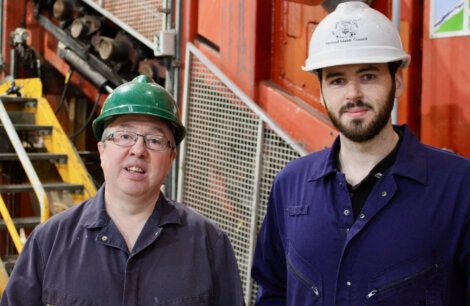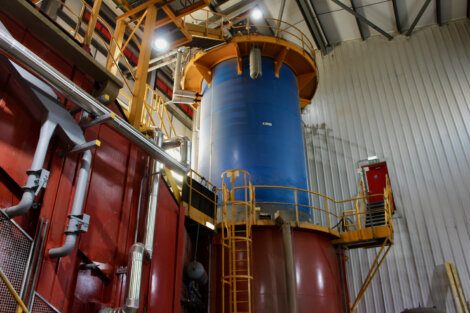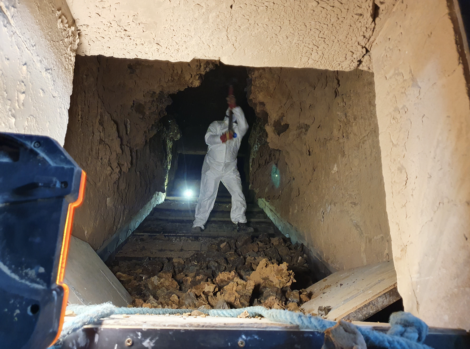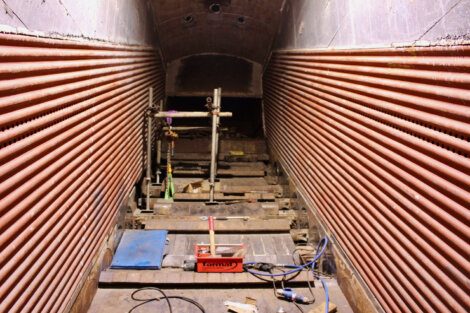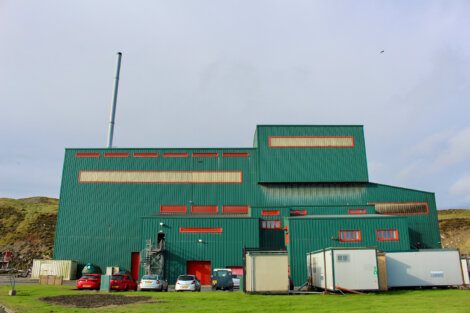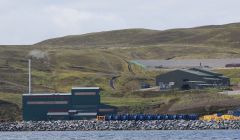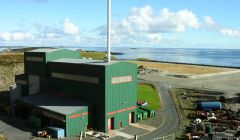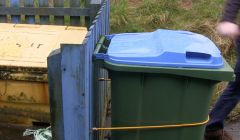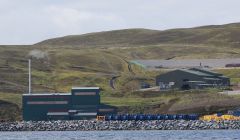Energy / Relight my fire: energy recovery plant prepares to switch back on after upgrade
A SIGNIFICANT upgrade of the energy recovery plant in Lerwick is nearing completion – a project designed to raise the facility up to “21st century standards”.
The £2.9 million project should make the plant, which burns non-recyclable waste to power Lerwick’s district heating system, more efficient.
The main focus of the upgrade is a new water-fed heat exchanger within the furnace, which is surrounded by concrete.
Staff have taken the opportunity to upgrade other parts of the council-owned facility at Gremista at the same time.
Shetland News was given a look around the plant this week ahead of the furnace being turned back on.
It should not be too much longer before the plant is fired up again, having been shut down since August, with the hope that public rubbish will start being burned again in November.
While the plant has been switched off, the district heating scheme – which provides water to heat more than 1,000 properties in Lerwick – has relied on boilers operated by Shetland Heat Energy & Power (SHEAP).
“The upgrade of the plant is going to bring it up to the 21st Century standards,” plant manager Bob Williamson says.
“We already had a really really clean operation, but the technology we were using was from the end of last century.”
The energy recovery plant, located opposite the dump, was built in 1999 and was described as “cutting edge” at the time.
The towering green building takes in waste from Shetland and Orkney, with rubbish piled into a huge heap at one end before it is grabbed upwards.
It is then passed through a furnace, which can reach up to a sweltering 1,100 degrees celsius, before the end product powers a gargantuan boiler.
A network of pipes snake around the building, leading out to the district heating system, while other infrastructure treats the output.
Become a member of Shetland News
Around three tonnes of bruck is processed a hour – no mean feat.
The upgrade project, which is being managed by the council’s Gareth Norquoy, should also increase the amount of hot water the plant produces.
It is also hoped to reduce the amount of shutdown days, which at the moment take place to allow staff to enter the furnace to break down ‘slag’ residue – a rock-like formation which builds up over time.
A bit like a slimmed-down NASA control centre for Shetland waste, staff can keep an eye on the plant’s operations from a control room which also overlooks the massive dump of waste.
Highlighting the vast scale of machinery on the go, one part of the room is lined with more than 40 large operating maintenance and safety manuals.
The during visit staff from Danish upgrade contractor Babcock & Wilcox Volund A/S are on hand to fine tune to the system.
The facility is one of a select number of plants in the UK, and a key selling point is how they divert waste from landfill and produce energy at the other end.
It still creates emissions, though, and has historically been fifth on the list of CO2 polluters in Shetland behind the gas plant, the Sullom Voe power station and terminal, and the Lerwick power station.
A recent Zero Waste Scotland report, however, reiterated that the Lerwick facility – the sole ‘heat-only’ incinerator in Scotland – is the best performing energy recovery plant in the country by some margin when it comes to greenhouse gas emissions per tonne.
Sending one tonne of rubbish to waste to energy plants in Scotland in 2018 emitted 15 per cent less greenhouse gas emissions than from sending it to landfill.
A government review is due to be held on the future of incineration in Scotland – with one environmental charity this week calling for a pause in any new plants while the review is ongoing.
But Williamson said the new upgrade should result in the Lerwick plant producing less emissions than before.
“It will clean our process up, and we will get more energy out of the waste we’re putting in,” he says. “We’ll also have the capacity to diversify more potentially with different waste streams as we go forward with trying to get a handle with the problem we have with waste and dealing with it.”
Williamson described the project as the “biggest piece of work that’s been done on this plant since it was built”.
“When it was built it was at the top of the scale of this kind of plant. What we’re doing is we’re just trying to keep pace with that and updating it.
“We’re not taking any huge chances – this stuff has all been done elsewhere, and we’re just bringing it onboard. We were at a time when the old plant was coming to the end of its useful life. We’re giving it a new lease of life.”
Meanwhile the council’s environment and estate operations manager Carl Symons said the upgrade project remains on time, on budget and is being delivered to the “highest quality standards”.
“Considering the challenges presented by both the ongoing pandemic and Brexit to travel and imports,” he added, “and the fact the team includes a Danish specialist contractor with fabricated components shipped over from Denmark, it’s testament to the hard work, planning and diligence of everyone involved.”
Become a member of Shetland News
Shetland News is asking its readers to consider paying for membership to get additional perks:
- Removal of third-party ads;
- Bookmark posts to read later;
- Exclusive curated weekly newsletter;
- Hide membership messages;
- Comments open for discussion.
If you appreciate what we do and feel strongly about impartial local journalism, then please become a member of Shetland News by either making a single payment, or setting up a monthly, quarterly or yearly subscription.






